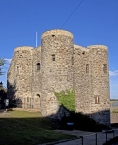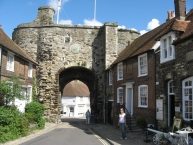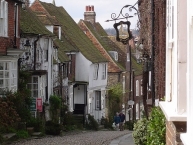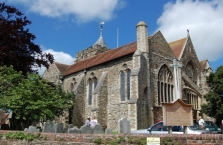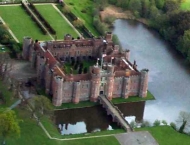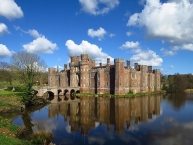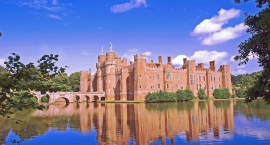Cycle Tour Rundtour durch Kent, Sussex, Hampshire und Surrey
Planned tour
Actions
![]()
Please wait - map data are loading
Added on 21 Jan 2020,
last edited by ThimbleU on 27 Jan 2020
Actions
Cycle route metrics
planned
ridden
Total distance in km
698
0
Cumulative elevation gain in m
5.856
0
Avg. slope uphill in %
0,84
-
Cumulative elevation loss in m
5.848
0
Information about rights to the gps-track data | |
|---|---|
Rights owner | ThimbleU & biroto-Contributors |
Rights characteristic / license | cc0: Public Domain no Rights reserved |
Link to the description of the license | |
GPX file taken from | |
GPX file uploaded | by ThimbleU on 27 Jan 2020
|
Track points in total
12.713
0
Track points per km (avg)
18
0
Start/endpoint
Start location
Dover, England, GB (8 m NHN)
End location
Dover, England, GB (16 m NHN)
Beds4Cyclists, worth visiting and infrastructure
Name and address
Latitude / Longitude
Phone
Fax
Mobile
Type of accommodation
Rating for cyclists
Route km
Dist. to route
Elevation
1 km
0,0 km
16 m
With 5 ships sailing every day between Dover and Dunkirk and Calais, you now have more flexibility than ever before when taking the ferry to France with DFDS Seaways. The crossing between Dover and Dunkirk takes 2 hours.
The Check in booths are open 24 hours excluding Christmas and Boxing day. Check in closes 45 minutes prior to each sailing.
Bewtween 8 and 11 sailings per day in each direction every two hours.
Price per adult including bicycle: about 30 €.
Information about copyright | |
|---|---|
Rights characteristic / license | by-sa: CREATIVE COMMONS Attribution-ShareAlike |
Link to the description of the license | |
taken over / edited on | 25 Jul 2014
|
taken over / edited by |
|
3 km
0,9 km
28 m
67 km
0,0 km
20 m
Information about copyright | |
|---|---|
Rights owner | |
Rights characteristic / license | by: CREATIVE COMMONS Attribution |
Link to the description of the license | |
Image taken over from | |
Image has been uploaded | by biroto-Redaktion on 23 Jan 2020
|
Information about copyright | |
|---|---|
Rights owner | |
Rights characteristic / license | by-sa: CREATIVE COMMONS Attribution-ShareAlike |
Link to the description of the license | |
Image taken over from | https://commons.wikimedia.org/wiki/File:Land_Gate,_Rye,_Sussex_-_geograph.org.uk_-_1219133.jpg |
Image has been uploaded | by biroto-Redaktion on 23 Jan 2020
|
Information about copyright | |
|---|---|
Rights owner | |
Rights characteristic / license | by-sa: CREATIVE COMMONS Attribution-ShareAlike |
Link to the description of the license | |
Image taken over from | https://commons.wikimedia.org/wiki/File:Mermaid_Street,_Rye_-_geograph.org.uk_-_72791.jpg |
Image has been uploaded | by biroto-Redaktion on 23 Jan 2020
|
Information about copyright | |
|---|---|
Rights owner | |
Rights characteristic / license | by-sa: CREATIVE COMMONS Attribution-ShareAlike |
Link to the description of the license | |
Image taken over from | https://commons.wikimedia.org/wiki/File:St_Mary_the_Virgin_Church_-_geograph.org.uk_-_854472.jpg |
Image has been uploaded | by biroto-Redaktion on 23 Jan 2020
|
Rye is a town in East Sussex ![]() .
.
See
The docks by the river.
Rye also has a 12th-century church, overlooking the town.
The old town town centre is very picturesque with its extreme cobblestone roads (ensure you wear sensible shoes), its many timber-framed houses, and the occasional traditional—though now slightly touristy—tearooms where you can enjoy cream tea.
There are many places which overlook the local scenery, from Rye Castle you can see out to Dungeness. Recently wind turbines have been placed near to Rye, which has changed the nature of the landscape.
- ⊙Rye Castle. Rye Castle (with Ypres Tower).
- ⊙Camber Castle (south of Rye along the A259), ☎ +44 1797 227784. Open by guided tour (a few days per year) only, see Sussex Wildlife Trust for dates. Adults £3.00, children free, concessions £1.50.
(updated Jun 2018)
- ⊙Lamb House, West St, TN31 7ES, ☎ +44 1580 762334. Henry James, EF Benson and Rumer Godden have all lived in this charming 18th century house. The home is owned by the National Trust.
Do
- Walk around the docks mentioned above, visit the many shops.
- Climb the church tower to get a magnificent view over Rye and its surroundings.
- Walk across the meadows to the ruins of Camber Castle (open on summer weekends; check with its owner, the English Heritage).
- Visit Ypres tower and have a chat with the elderly gentleman who has been keeping it open for visitors for the last 15 years. Get locked in in one of its small, dark cells!
Information about copyright | |
|---|---|
Rights characteristic / license | by-sa: CREATIVE COMMONS Attribution-ShareAlike |
Link to the description of the license | |
Input taken over from: |
Wikivoyage contributors, 'Rye (England)', Wikivoyage, The FREE worldwide travel guide that anyone can edit, 19 October 2019, 12:39 UTC, https://en.wikivoyage.org/w/index.php?title=Rye_(England)&oldid=3866143 [accessed 23 January 2020] |
taken over / edited on | 23 Jan 2020
|
taken over / edited by |
|
87 km
0,1 km
20 m
Hastings is a seaside town in East Sussex, in the South East of England.
Understand
Hastings is most famous for the battle that took place there in 1066 between King Harold's English and William the Conqueror's Normans. The town lent its name to the battle, although the battle took place in nearby Battle (these were imaginative times.)
The town grew from its medieval origins into a Victorian seaside resort, and the majority of the towns architecture dates from this period. Today, along with St Leonards on Sea, Hastings forms a fairly large urban area on the south coast of around 100,000 inhabitants.
Nestled between the rugged beauty of the East and West Hills, the town's main attraction is the medieval Old Town, with its narrow passageways, antique shops, boutiques, cafe's and Europe's largest beach-launched fishing fleet. The town also boasts a hill-top castle, two funicular railways, the Georgian church of St Mary in the Castle, 18th-century net shops, and access to Hastings Country Park - a 660 acres (270 hectares) Nature Reserve with woodland glens, beaches and cliff-top views.
Away from the Old Town, Hastings largely retains the character of a Victorian seaside resort, with seafront squares, grand Victorian facades, elegant parks and a pier. However, the town suffered from the post-war decline in the seaside tourist industry in England and while there has been significant investment in regenerating the area, parts of the seafront have seen better days.
See
- ⊙Hastings Castle, Castle Hill Road, West Hill, TN34 3AR, ☎ +44 8445 499088.
(updated Oct 2017)
- Pier.
- ⊙The Stade (in the old town). The home of Europe's largest beach-launched fishing fleet, and the historic net huts.
- ⊙Smugglers Adventure, St Clement’s Caves, TN34 3JJ, ☎ +44 1424 422964. 10AM-5:30PM. A set of caves (St Clements Caves) in the hills above the town.
- ⊙Blue Reef Aquarium (previously Underwater World), Rock-A-Nore Rd, TN34 3DW, ☎ +44 1424 718776. 10AM-5PM. An aquarium.
- ⊙St Mary in the Castle, 7 Pelham Crescent, TN34 3AF, ☎ +44 1424 715880. A grade II listed former Georgian church beneath the castle in the Regency Square - Pelham Crescent. The space is now used as a gallery, theatre and performance venue. (updated Oct 2017)
- ⊙Jerwood Gallery, Rock-A-Nore Rd, TN34 3DW, ☎ +44 1424 728377. M closed, Tu-Sa 11AM-5PM. A contemporary (but controversial) art gallery on The Stade.
(updated Oct 2017)
- Hastings from the cliffs - a view of Hastings up on the cliffs, travelled to on the cliff railways.
Information about copyright | |
|---|---|
Rights characteristic / license | by-sa: CREATIVE COMMONS Attribution-ShareAlike |
Link to the description of the license | |
Input taken over from: |
Wikivoyage contributors, 'Hastings (England)', Wikivoyage, The FREE worldwide travel guide that anyone can edit, 14 April 2019, 21:52 UTC, https://en.wikivoyage.org/w/index.php?title=Hastings_(England)&oldid=3761736 [accessed 23 January 2020] |
taken over / edited on | 23 Jan 2020
|
taken over / edited by |
|
114 km
0,1 km
14 m
Information about copyright | |
|---|---|
Rights owner | |
Rights characteristic / license | by-sa: CREATIVE COMMONS Attribution-ShareAlike |
Link to the description of the license | |
Image taken over from | https://commons.wikimedia.org/wiki/File:Herstmonceux_castle_aerialview.jpg |
Image has been uploaded | by biroto-Redaktion on 22 Jan 2020
|
Information about copyright | |
|---|---|
Rights owner | |
Rights characteristic / license | by-sa: CREATIVE COMMONS Attribution-ShareAlike |
Link to the description of the license | |
Image taken over from | https://commons.wikimedia.org/wiki/File:Herstmonceux_Castle_with_moat.jpg |
Image has been uploaded | by biroto-Redaktion on 22 Jan 2020
|
Information about copyright | |
|---|---|
Rights owner | |
Rights characteristic / license | by-sa: CREATIVE COMMONS Attribution-ShareAlike |
Link to the description of the license | |
Image taken over from | https://commons.wikimedia.org/wiki/File:Herstmonceux_Castle_-_far_view.jpg |
Image has been uploaded | by biroto-Redaktion on 23 Jan 2020
|
Herstmonceux Castle is a brick-built castle, dating from the 15th century, near Herstmonceux , East Sussex, England. It is one of the oldest significant brick buildings still standing in England. The castle was renowned for being one of the first buildings to use that material in England, and was built using bricks taken from the local clay, by builders from Flanders. It dates from 1441. Construction began under the then-owner, Sir Roger Fiennes and then, from his death in 1449, by his son, Lord Dacre.
The parks and gardens of Herstmonceux Castle and Place are Grade II* listed on the Register of Historic Parks and Gardens. Other listed structures on the Herstmonceux estate include the Grade II listed walled garden to the north of the castle, and the Grade II* listed telescopes and workshops of the Herstmonceux Science Centre.
Early history
The first written evidence of the existence of the Herst settlement appears in William the Conqueror's Domesday Book which reports that one of William's closest supporters granted tenancy of the manor at Herst to a man named ‘Wilbert'. By the end of the twelfth century, the family at the manor house at Herst had considerable status. Written accounts mention a lady called Idonea de Herst, who married a Norman nobleman named Ingelram de Monceux. Around this time, the manor began to be called the "Herst of the Monceux", a name that eventually became Herstmonceux.
A descendant of the Monceux family, Roger Fiennes, was ultimately responsible for the construction of Herstmonceux Castle in the County of Sussex. Sir Roger was appointed Treasurer of the Household of Henry VI of England and needed a house fitting a man of his position, so construction of the castle on the site of the old manor house began in 1441. It was this position as treasurer which enabled him to afford the £3,800 construction of the original castle.
In 1541, Sir Thomas Fiennes, Lord Dacre, was tried for murder and robbery of the King's deer after his poaching exploits on a neighboring estate resulted in the death of a gamekeeper. He was convicted and hanged as a commoner, and the Herstmonceux estate was temporarily confiscated by Henry VIII of England, but was restored to the Fiennes family during the reign of one of Henry's children.
The profligacy of the 15th Baron Dacre, heir to the Fiennes family, forced him to sell in 1708 to George Naylor, a lawyer of Lincoln’s Inn in London. Bethaia Naylor, who became the heiress of Herstmonceux on the death of her brother's only daughter, married Francis Hare and produced a son, Francis, who inherited in turn, his mother's property. The castle eventually came into the possession of Robert Hare-Naylor, who, upon the nagging of his second wife, Henrietta Henckell, followed the architect Samuel Wyatt’s advice to reduce the Castle to a picturesque ruin by demolishing the interior. Thomas Lennard, 17th Baron Dacre, was sufficiently exercised as to commission James Lamberts Jnr of Lewes (1741-1799) to record the building in 1776. The castle was dismantled in 1777 leaving the exterior walls standing and remained a ruin until the early 20th century.
20th-century restoration
Radical restoration work was undertaken by Colonel Claude Lowther in 1913 to transform the ruined building into a residence and, based on a design by the architect, Walter Godfrey, this work was completed by Sir Paul Latham in 1933. The existing interiors largely date to this period, incorporating architectural antiques from England and France. The one major change in planning was the combination of the four internal courtyards into one large one. The restoration work, regarded as the apex of Godfrey's architectural achievement, was described by the critic Nikolaus Pevsner as executed 'exemplarily'.
Information about copyright | |
|---|---|
Rights characteristic / license | by-sa: CREATIVE COMMONS Attribution-ShareAlike |
Link to the description of the license | |
Input taken over from: |
Wikipedia contributors, 'Herstmonceux Castle', Wikipedia, The Free Encyclopedia, 10 December 2019, 05:54 UTC, https://en.wikipedia.org/w/index.php?title=Herstmonceux_Castle&oldid=930096454 [accessed 23 January 2020] |
taken over / edited on | 23 Jan 2020
|
taken over / edited by |
|
Hours of opening
April to September 10am - 6pm
February, March, October & November 10am - 5pm.
![]()

